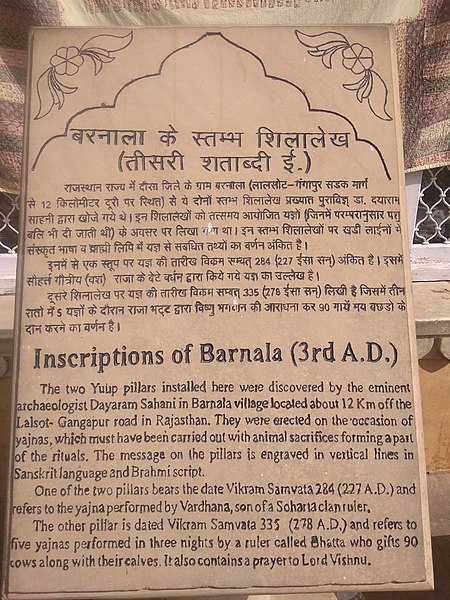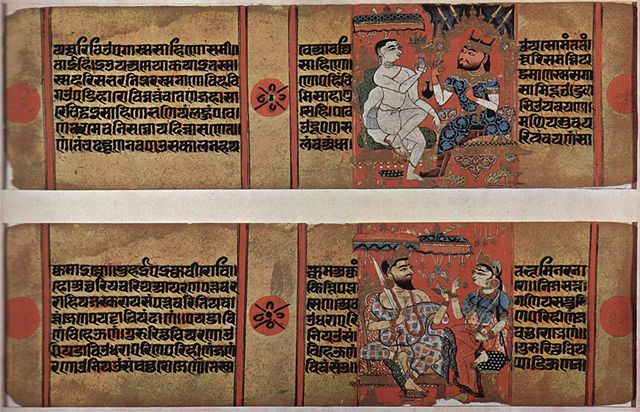
| VIKRAM SAMVAT Vikram Samvat (IAST: Vikrama Samvat; abbreviated V.S. (or VS) and B.S. (or BS)) and also known as the Vikrami calendar, is the historical Hindu calendar in the Indian subcontinent. It is the official calendar of Nepal. In India it is used in several states. The calendar uses lunar months and solar sidereal years.
History
:
Plaque with description of Barnala inscription
Barnala Stup pillar, Rajasthan A number of ancient and medieval inscriptions used the Vikram Samvat. Although it was reportedly named after the legendary king Vikramaditya, the term "Vikram Samvat" does not appear in the historical record before the 9th century; the same calendar system is found with other names, such as Krit and Malav. In colonial scholarship, the era was believed to be based on the commemoration of King Vikramaditya expelling the Sakas from Ujjain. However, later epigraphical evidence and scholarship suggest that this theory has no historical basis. During the 9th century, epigraphical artwork began using Vikram Samvat (suggesting that the Hindu calendar era in use became popular as Vikram Samvat); Buddhist and Jain epigraphy continued to use an era based on the Buddh or the Mahavir.
Vikramaditya legend :
The Jain monk Kalakacharya and the Saka king (Kalakacharya Katha manuscript, Chhatrapati Shivaji Maharaj Vastu Sangrahalay, Mumbai) According to popular tradition, King Vikramaditya of Ujjain established the Vikram Samvat era after defeating the Sakas.
Kalakacharya Kathanak (An account of the monk Kalakacharya), by the Jain sage Mahesarasuri, gives the following account: Gandharvasen, the then-powerful king of Ujjain, abducted a nun called Sarasvati, who was the sister of the monk. The enraged monk sought the help of the Saka ruler King Sahi in Sistan. Despite heavy odds but aided by miracles, the Saka king defeated Gandharvasen and made him a captive. Sarasvati was repatriated, although Gandharvasen himself was forgiven. The defeated king retired to the forest, where he was killed by a tiger. His son, Vikramaditya, being brought up in the forest, had to rule from Pratishthan (modern Paithan in Maharashtra). Later on, Vikramaditya invaded Ujjain and drove away from the Sakas. To commemorate this event, he started a new era called the "Vikrama era". The Ujjain calendar started around 58–56 BCE, and the subsequent Shaka-era calendar was started in 78 CE at Pratishthana.[full citation needed]
Historical
origins :
A number of authors believe that the Vikram Samvat was not started by Vikramaditya, who might be a legendary king or a title adopted by a later king who renamed the era after himself. V. A. Smith and D. R. Bhandarkar believed that Chandragupt II adopted the title of Vikramaditya, and changed the era's name to "Vikrama Samvat". According to Rudolf Hoernlé, the king responsible for this change was Yashodharman. Hoernlé believed that he conquered Kashmir and is the "Harsha Vikramaditya" mentioned in Kalhana's Rajatarangini.
Some earlier scholars believed that the Vikram Samvat corresponded to the Azes era of the Indo-Scythian (Saka) king King Azes. This was disputed by Robert Bracey after the discovery of an inscription of Vijayamitra, which is dated in two eras. The theory was discredited by Falk and Bennett, who place the inception of the Azes era in 47–46 BCE.
Popularity
:
The calendar remains in use by Hindus in Nepal and north, west and central India. In south India and portions of east and west India (such as Assam, West Bengal and Gujarat), the Indian national calendar is widely used.
With the arrival of Islamic rule, the Hijri calendar became the official calendar of sultanates and the Mughal Empire. During British colonial rule of the Indian subcontinent, the Gregorian calendar was adopted and is commonly used in urban areas of India. The predominantly-Muslim countries of Pakistan and Bangladesh have used the Islamic calendar since 1947, but older texts included the Vikram Samvat and Gregorian calendars. In 2003, the India-based Sikh Shiromani Gurdwara Parbandhak Committee controversially adopted the Nanakshahi calendar. The Vikram Samvat is the official calendar of Nepal.
Calendar
system :
The Vikram Samvat has two systems. It began in 56 BCE in the southern Hindu calendar system (amaant) and 57–56 BCE in the northern system (purnimaant). The Shukla Paksh, when most festivals occur, coincides in both systems. The lunisolar Vikram Samvat calendar is 56.7 years ahead of the solar Gregorian calendar; the year 2076 VS began in 2019 CE, and ended in 2020 CE.
The Rana dynasty of Nepal made the Vikram Samvat the official Hindu calendar in 1901, which began as Samvat 1958. The new year in Nepal begins with the first day of the month of Baishakh, which usually falls around 13–15 April in the Gregorian calendar. The first day of the new year is celebrated in Bisket Jatra, an annual carnival in Bhaktapur. In 2007, Nepal Samvat was recognized as the national calendar.
In India, the reformulated Saka calendar is officially used (except for computing dates of the traditional festivals). In the Hindi version of the preamble of the constitution of India, the date of its adoption (26 November 1949) is presented in Vikram Samvat as Margsheersh Shukla Saptami Samvat 2006. A call has been made for the Vikram Samvat to replace the Saka calendar as India's official calendar.
Divisions
of a year :
Lunar
metrics :
1.
Vaisakh (April–May)
Source :
https://en.wikipedia.org/ |


